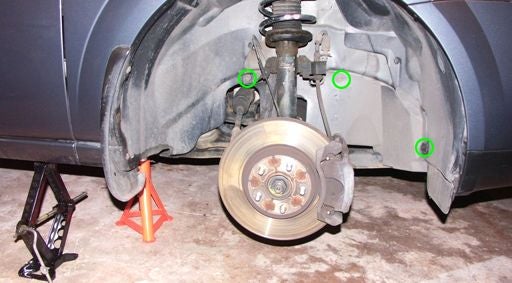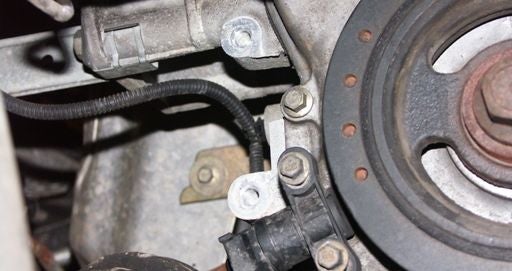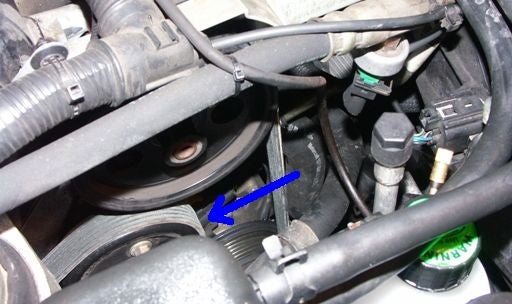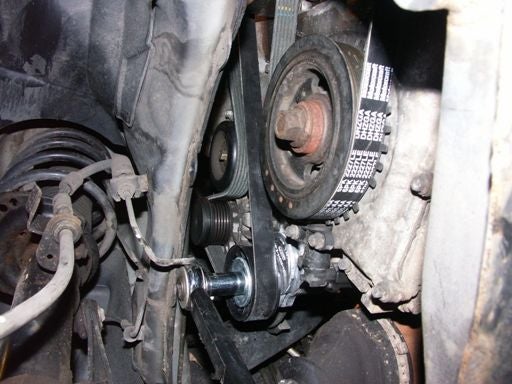Registrations
We now manually approve all new user accounts due to a large influx of spam bots. Accounts are normally approved within 48 hours.
If you need any help with using this Wiki, please ask here: TalkFord.com Wiki Submission Forum
Difference between revisions of "Auxiliary belt tensioner replacement"
52graphite (Talk | contribs) |
52graphite (Talk | contribs) |
||
| Line 4: | Line 4: | ||
Replacement is fairly easy despite the location, but the part isn't cheap. You may also want to replace the belt at the same time - the normal service interval is 150k miles or 10 years, so if you're close to this, do it. You need to partially remove the belt anyway, so replacement is little extra work, just extra cost. | Replacement is fairly easy despite the location, but the part isn't cheap. You may also want to replace the belt at the same time - the normal service interval is 150k miles or 10 years, so if you're close to this, do it. You need to partially remove the belt anyway, so replacement is little extra work, just extra cost. | ||
| + | |||
| + | This involves working on a jacked-up car and fiddling with bits that, if incorrectly replaced, could cuase engine damage. If you're not comfortable with this, get a garage to do it for you. | ||
== Parts needed == | == Parts needed == | ||
| Line 26: | Line 28: | ||
=== Accessing the part === | === Accessing the part === | ||
| − | + | * Loosen the wheelnuts on the RH front roadwheel. | |
| − | + | * Jack up the RH front of the car. Pay attention to the [[Jacking Points|jacking points]]. | |
| − | + | * Support the car on an axle stand at an appropriate point. You'll be pulling the car around - the standard jack isn't intended for this level of work. | |
| − | + | * Remove the wheelnuts and the wheel. | |
| − | + | * Remove the one 8mm and two 10mm headed screws from the lower front plastic cover - circled in green below. | |
[[Image:Abt2.jpg]] | [[Image:Abt2.jpg]] | ||
| Line 40: | Line 42: | ||
=== Removal === | === Removal === | ||
| + | * Using a 15mm socket, apply clockwise torque to the pulley bolt. This should work against the spring action of the tensioner, loosening the belt. Again, be very careful not to damage the brake pipe - or your knuckles on the sheet metal edge of the wheelarch. Pull the loose belt off the crankshaft pulley and release the pulley. | ||
[[Image:Abt4.jpg]] | [[Image:Abt4.jpg]] | ||
| + | |||
| + | * Undo the two 10mm bolts holding the tensioner to the block and remove. If necessary, clean up the exposed face of the block. | ||
[[Image:Abt5.jpg]] | [[Image:Abt5.jpg]] | ||
| − | + | * If you're replacing the belt, remove the old one completely from the top. Ensure that you either know the routing or have a Haynes manual to hand. | |
| + | |||
| + | === Fitting === | ||
| + | |||
| + | * Fit the new tensioner using the old bolts. Tighten both bolts to 25Nm. | ||
| + | * Refit the belt (new if appropriate), leaving it off the plain non-flanged pulley arrowed in blue below (view from top of engine). This is the easiest point to finish the belt fitment. | ||
[[Image:Abt7.jpg]] | [[Image:Abt7.jpg]] | ||
| + | |||
| + | * Loosen the new tensioner using a 15mm socket as above and refit the belt. You may find it easiest to fix the socket driver bar to the front hub carrier below the driveshaft. I used a nylon strap with cleat to hold it in position whilst finalizing the belt fitment. | ||
| + | * Release the tensioner and check the belt is correctly routed over all pulleys. | ||
| + | |||
| + | [[Image:Abt6.jpg]] | ||
| + | |||
| + | * Refit the wheel arch liner part. | ||
| + | * Refit the road wheel, partially tightening the nuts. | ||
| + | * Lower the car and fully tighten the wheel nuts (85Nm for stock pre-facelift wheels). | ||
| + | |||
| + | == Testing == | ||
| + | |||
| + | Double-check belt routing, then very briefly run the engine. Ensure the belt is still in position, then run it for longer. Hopefully, your noise should have gone. | ||
| + | |||
| + | [[Category:Mk3]] | ||
| + | [[Category:Petrol]] | ||
| + | [[Category:Mechanical]] | ||
Revision as of 19:07, 26 December 2008
Gradual failure of the auxiliary belt tensioner on the Mk3 petrol is fairly common, causing a tinny rattle to the engine, particularly at idle. It also causes superfluous vibration of the belt, which must accelerate wear of the components it drives: the water pump, A/C compressor, alternator and power steering pump.
If you think your tensioner is on the way out, listen carefully with the bonnet open, the engine cover removed and the engine running at idle. The aux belt is on the left hand side as you stand at the front of the car looking at the engine. Obviously, keep clothing and hair out of the way of the running belt! The alternator can be seen at the back of this side at the top - the tensioner is at the bottom of the engine directly below it. The Haynes manual is sadly quiet on replacement, so here's a quick guide.
Replacement is fairly easy despite the location, but the part isn't cheap. You may also want to replace the belt at the same time - the normal service interval is 150k miles or 10 years, so if you're close to this, do it. You need to partially remove the belt anyway, so replacement is little extra work, just extra cost.
This involves working on a jacked-up car and fiddling with bits that, if incorrectly replaced, could cuase engine damage. If you're not comfortable with this, get a garage to do it for you.
Contents
Parts needed
- New tensioner (FINIS 1371224, 1S7Q-6A228-A*)
- New belt if you choose to do this (FINIS 1120198, 1S7Q-6C301-A*)
Tools needed
- Wheelbrace & alloy wheel key if required
- Jack
- Axle stand (optional, but recommended)
- 8, 10 and 15mm sockets
- Torque wrench to do the job properly
Method
It's best to clean up as much as possible prior to starting work. Give the car a good wash, including the wheels and wheelarches.
Accessing the part
- Loosen the wheelnuts on the RH front roadwheel.
- Jack up the RH front of the car. Pay attention to the jacking points.
- Support the car on an axle stand at an appropriate point. You'll be pulling the car around - the standard jack isn't intended for this level of work.
- Remove the wheelnuts and the wheel.
- Remove the one 8mm and two 10mm headed screws from the lower front plastic cover - circled in green below.
That should give you access to the tensioner, arrowed in green. When working, take care to avoid damaging the crankshaft position sensor (arrowed in red) and the brake line (partially obscuring the tensioner pulley).
Removal
- Using a 15mm socket, apply clockwise torque to the pulley bolt. This should work against the spring action of the tensioner, loosening the belt. Again, be very careful not to damage the brake pipe - or your knuckles on the sheet metal edge of the wheelarch. Pull the loose belt off the crankshaft pulley and release the pulley.
- Undo the two 10mm bolts holding the tensioner to the block and remove. If necessary, clean up the exposed face of the block.
- If you're replacing the belt, remove the old one completely from the top. Ensure that you either know the routing or have a Haynes manual to hand.
Fitting
- Fit the new tensioner using the old bolts. Tighten both bolts to 25Nm.
- Refit the belt (new if appropriate), leaving it off the plain non-flanged pulley arrowed in blue below (view from top of engine). This is the easiest point to finish the belt fitment.
- Loosen the new tensioner using a 15mm socket as above and refit the belt. You may find it easiest to fix the socket driver bar to the front hub carrier below the driveshaft. I used a nylon strap with cleat to hold it in position whilst finalizing the belt fitment.
- Release the tensioner and check the belt is correctly routed over all pulleys.
- Refit the wheel arch liner part.
- Refit the road wheel, partially tightening the nuts.
- Lower the car and fully tighten the wheel nuts (85Nm for stock pre-facelift wheels).
Testing
Double-check belt routing, then very briefly run the engine. Ensure the belt is still in position, then run it for longer. Hopefully, your noise should have gone.







 Your Privacy Choices
Your Privacy Choices